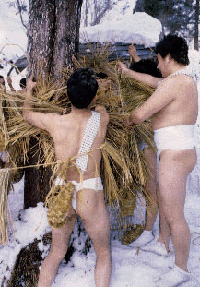Hadaka-Mairi (Naked Pilgrimage)
In May of the year 1877, there were only about 15 households in Matsuba village in Shimohinokinai, which now has over 100. That day, it was so dry that the manure on the roads were blown away by the strong spring wind. Risaburo's house, among the hills of the village, was busy making soybean paste. When it was nearly noon, the fire of the cooking pot suddenly went out of control, and the thatched-roof house went up in flames. The strong wind made the fire spread to the nearby houses in a matter of moments.

Although the villagers did everything they could to stop the fire, it did not even slow down. Completely burning down Matsuba village, the demonic fire jumped across Ainaisawa River and reached the Kamifujis' house in Ainai village 500m away to the east, burning it down. The fire destroyed a total of 14 houses and finally stopped in the evening. A spring day of cherry blossoms became a nightmare of inferno.
Matsuba village had another fire in the same year. To protect the village from the repeated misfortunes, they planned to make a pilgrimage to the Konpira Shrine in Shikoku. The enshrined gods of Konpira are Omononushinokami and Emperor Sudoku, gods of protection against misfortunes. Jinjuro and 6 other household owners were chosen, and they went to Konpira Shrine. There they prayed for prevention of fires, received amulets of the Konpira Shrine, and returned to the village. The villagers built a small shrine in Asahiyama, the center of the area, and enshrined the amulets. This became the village's Konpira Shrine, and every year, on the third Sunday of February, the Hadaka-Mairi ritual is performed for fire prevention. Participants for the festival need to be out of imi (certain states of unluckiness) for a year, and houses with pregnant women or newborns are not chosen.

The young men take a lustral bath in Hinokinai Stream, put on Kendai (straw clothing) around their waist and white tabi socks with waraji sandals, and run around the village yelling with gallant voices. On a cross-road on the way, they receive nejiri-hatuho and candles, and run up Asahiyama to the Konpira Shrine to pray for fire prevention. When the prayer is done, they take off their kendais and warajis and tie them to the sacred trees, have sacred sake and come down the mountain. In the designated houses, helper women prepare Sasagori and await the young men.
When the young men come back with their bodies scarlet with the cold, they report to the designated house's Uchigami gods. Then comes the Naorai, where the whole village gather and feast all night, and the newly wedded couples of the year are introduced to everybody.
The Hadaka-Mairi preserves its rustic style to this day, and reminds us of local religion. The Lunar New Year festival of the mountain village continues to be passed down from hand to hand.
| Location | Matsuba, Hinokinai, Nishiki |
|---|---|
| Contact Info | Semboku City Nishiki Area Center, Regional Development Section: 0187-43-2244 |
| Traffic access | Five minutes on foot from Akita Nairiku Line Matsuba Station |
| Shedule | The third Sunday of February |
- Access
- Sightseeing Spots
- Choose from areas
- Hachimantai/Tamagawa
- Nyutou
- Tazawako Plateau/Mizusawa/Komagatake
- Tazawako
- Dakigaeri/Jindai/Shiraiwa
- Nishiki
- Kakunodate
- Seasonal Recomendations
- Lists by Season
- Campgrounds
- Products
- Other
